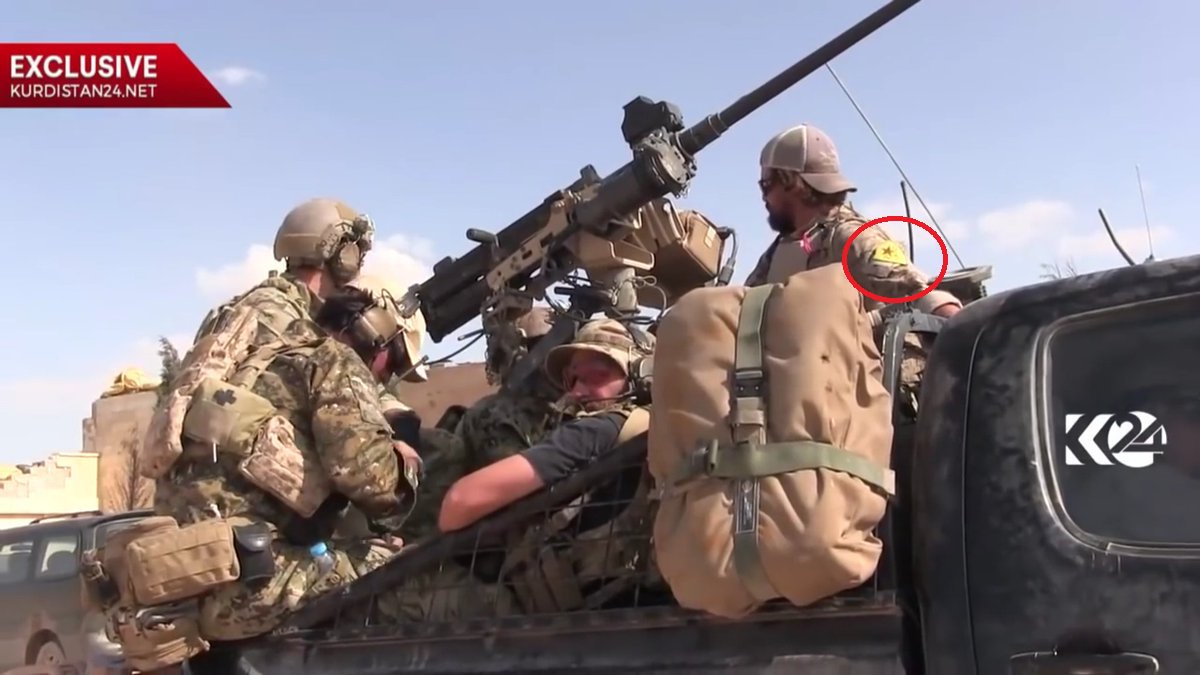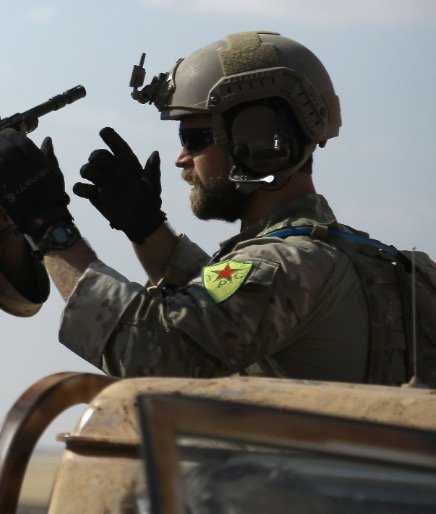Typical bully, country "I" does qualify as a rogue state. Something similar in September 18, 1931.How convenient for the rebels that Israel holds the Syrian government accountable regardless of who hits Israeli territory, may as well be a signal flare.
You are using an out of date browser. It may not display this or other websites correctly.
You should upgrade or use an alternative browser.
You should upgrade or use an alternative browser.
ISIS/ISIL conflict in Syria/Iraq (No OpEd, No Politics)
- Thread starter Jeff Head
- Start date
Jura The idiot
General
Jura The idiot
General
another By
"For their sacrifice on the battlefield, these foreign jihadists have been awarded land in Syria; primarily in the Idlib and Latakia governorates."
The French artillery will point their guns to Mosul
Photos of French equipment arriving (passing?), There are some days in the Iraqi base Makhmur, south of Mosul (see map below with the two red dots on Makhmur, another on the BA of Qayyarah), testimony to the French building in the north.
This building, after transit via Air Base Erbil (Kurdistan), is built around an artillery group whose resources (material and human) were provided by the Metropolitan artillery regiments (not 5th Leather based in the UAE), by the Legion elements (for Force Protection). These means are reinforced by train components (see the photo of a PPT on a carrier):
The French have thus joined ( "temporarily" according to EMA) their US comrades who settled in the base recovery in Daech in March. The Americans then made it 200 marines of Task Force Spartan and baptized Iraqi base named Firebase Bell. See the photo of an M777A2, taken on March 18

Jura The idiot
General
remember those photo-ops?
May 26, 2016
Jun 4, 2016
that's what I noticed in Twitter, reportedly it's like now:

May 26, 2016
... are pictures, available in Twitter today, which purport to show US SF disguised as Kurdish fighters:

(of course it may be a fake, so I won't post more of these)
Jun 4, 2016
for our Canadian member
Canadian military brass to review whether soldiers should continue wearing Kurdish flag

source:
that's what I noticed in Twitter, reportedly it's like now:

Jura The idiot
General
LOL! great to see a map posted here
for scale, I checked
Jura The idiot
General
originally I noticed in Russian Internet
AP sources: US to shift military assets to Syria under deal
AP sources: US to shift military assets to Syria under deal
source:The U.S. military will have to shift surveillance aircraft from other regions and increase the number of intelligence analysts to coordinate attacks with Russia under the Syria cease-fire deal partly in order to target militants the U.S. has largely spared, senior officials say.
Senior defense and military officials told The Associated Press that they are sorting out how the U.S.-Russia military partnership will take shape and how that will change where U.S. equipment and people will be deployed. They said, however, that they will need to take assets from other parts of the world, because U.S. military leaders don't want to erode the current U.S.-led coalition campaign against the Islamic State group in Iraq and Syria.
More military planners and targeting experts will be needed to identify and approve airstrikes against the al-Qaida-linked Jabhat Fatah al-Sham. The U.S. has rarely bombed the group, previously known as the Nusra Front, and the targeting is trickier because the militants are often intermingled with other U.S.-backed Syrian rebels.
Making matters more complicated are U.S. military concerns about Russian targeting. Unlike the U.S., which uses precision-guided munitions, Moscow has predominantly used so-called dumb bombs in its airstrikes over Syria.
The Syria cease-fire deal struck by U.S. Secretary of State John Kerry and Russian Foreign Minister Sergey Lavrov is designed to bring a pause to the civil war so that the superpowers' militaries can be jointly concentrated against the Islamic extremist groups operating within the chaos on the ground. The concerns reflect the U.S. military's broader skepticism about partnering with Russia, which it says it distrusts.
Senior U.S. defense and military officials familiar with the planning spoke on condition of anonymity because they weren't authorized to talk about the matter publicly.
Under the deal, if the cease-fire holds for seven days and humanitarian deliveries are allowed into areas besieged by the Syrian army, the U.S. and Russia would set up a so-called Joint Implementation Center to focus on the militants and share basic targeting data.
State Department spokesman Mark Toner acknowledged the skepticism.
"I don't think that anyone in the U.S. government is necessarily taking at face value Russia's or certainly not the Syrian regime's commitment to this arrangement," Toner said. "I also think some of the comments from the Department of Defense were just about speaking to the fact that there's logistical challenges of setting up the JIC (joint center) and coordinating these airstrikes and that's going to require additional effort and additional time."
He added, however, "What really matters here is that the president of the United States supports this agreement, and our system of government works in such a way that everyone follows what the president says."
U.S. defense officials said they have begun working out some of the details, even though they are hamstrung by existing U.S. law that prohibits any military-to-military relations with Russia in the aftermath of Moscow's annexation of the Crimea region of Ukraine.
Defense Secretary Ash Carter must submit a waiver to Congress along with a report detailing why military cooperation with Russia is necessary. U.S. officials said Carter hasn't done that yet, and he likely won't until the required cease-fire and humanitarian aid conditions are met for seven days.
Until then, officials said the U.S. military team setting up the JIC will not be able to meet with their Russian counterparts. The U.S. officials laid out a number of questions that must be resolved before any targeting could start, including how much control either country may have over strikes taken by the other, how the review process will unfold and the question of whether either Washington or Moscow will have a veto over any target in dispute - and who would be the final arbiter in any such disagreements.
Other officials have said they believe there is no veto authority on either side, and that the U.S. would bear no responsibility if a Russian strike killed civilians. And they have made it clear that the U.S. would end the cooperation if Russia violated the agreement and killed civilians or U.S. allies.
A key question will be where the military will get the additional surveillance aircraft needed. Drones, in particular, are in high demand around the world, and commanders in volatile regions including Asia and the Middle East, won't be eager to give up theirs.
The U.S. hasn't targeted much in some portions of Syria, including around Aleppo and regions where al-Qaida-linked militants are centered. The additional surveillance and analysis will be needed to identify and vet those targets to ensure friendly forces and innocent people aren't mixed in.
Military officials said that even once the proposed U.S.-Russian center is set up, airstrikes won't start happening immediately. They said it will take time to share and analyze the recommended target data and make certain that innocent civilians or allies aren't hit.
It can take weeks for a particular enemy target to get approved and added to the air-tasking order that the U.S.-led coalition uses to assign airstrikes in Iraq and Syria.
With interesting charts
Britain has spent £84.4m on weapons bombing Islamic State
Figures released to the House of Commons show the total cost of using munitions such as Paveway guided bomb variants (£23,000), Brimstone (£105,000) and Hellfire missiles (£70,000) reached £84.4m in August.
Figures have also shown that British combat aircraft have fired 26 of the highly capable Brimstone missiles at targets in Syria since operations began.
Brimstone is an air-launched ground attack missile developed by MBDA for the Royal Air Force. It was originally intended for “fire-and-forget” use against mass formations of enemy armour.
Experience in Afghanistan led to the addition of laser guidance in the dual-mode Brimstone missile, allowing a “spotter” to pick out specific targets when friendly forces or civilians were in the area.
The Ministry of Defence recently revealed that British aircraft have carried out more than a thousand air strikes against Islamic State in Iraq and Syria, without civilian causalities.
While military operations are never without risk to civilians, UK forces strive for the highest level of accuracy. That is why the RAF uses precise, low collateral weapons systems like Brimstone supported by thorough intelligence.
According to Mike Penning, Minister of State for the Armed Forces:
“It is difficult to correlate the number of sorties and weapon types utilised as one sortie can often constitute multiple weapons releases, possibly of different munition types. The following table details the total number of sorties, and those with weapons released, as of 25 August 2016.
All UK strikes, in support of the Coalition, are undertaken as part of a rigorous targeting process, which assesses the situation before, during and after a strike to ensure adherence to the Law of Armed Conflict. It should be noted that frequently sorties will be flown in Syria with weapons released that may also have had weapons released in Iraq.”
CHARTS
The Ministry of Defence has said the UK has carried out more than 1,000 air strikes against Islamic State in Iraq and Syria reportedly without causing any civilian casualties, over 3,000 armed sorties have now been flown since operations started.
In September 2014, Tornado GR4 strike aircraft of No. 2 Squadron began flying armed sorties over Iraq in support of Operation Shader, the UK’s contribution to the Military intervention against the Islamic State. On September 30th, the aircraft flew their first bombing raids, engaging a heavy artillery position with a Paveway IV laser-guided bomb and an armed pickup truck with a Brimstone air-to-ground missile.
Brimstone is the preferred weapon for these kinds of targets because it is the only air-launched low-fragmentation fire-and-forget weapon that is effective against moving targets that the allied inventory possesses.
In December 2015 the UK started using Brimstone missiles in Syria.
Around £10 million of Brimstones from the RAF stock were sold to the Royal Saudi Air Force for use on their Tornado jets. In April 2011, the RAF’s Assistant Chief of the Air Staff Air Vice-Marshal Baz North reported that the missiles were “being sought by both the United States of America and the French” in the light of Brimstone’s success in Libya.
Absolute madness!
Some Eighty Syrian Soldiers killed by US Airstrike as they fought off an ISIS offensive in the besieged city of Deir Ezzor
This will probably kill the Cease Fire and most likely any attempt at a Peace Process.
Some Eighty Syrian Soldiers killed by US Airstrike as they fought off an ISIS offensive in the besieged city of Deir Ezzor
This will probably kill the Cease Fire and most likely any attempt at a Peace Process.
